Why Do You NEED a Leadership Style?
“Where there is no vision, the people perish.”
– The Bible, Proverbs 29:18
If we had ever doubted the role of a good leader, the last year showed how important it is to have vision, foresight, and the ability to inspire in the face of a crisis. An organisation’s leaders — at every level — are key to empowering your people with skills and enforcing the processes necessary to reach success. So much is said about good, harmful, and ineffective leadership, and I spoke recently about the crucial role of compassionate leadership in a book launch during July 2021.
Leadership and management are two distinctly separate sets of behaviours. Nevertheless, successful leaders are clear about their authentic expression of what it means to be a leader.
An article that I read from HBR titled “How to Develop Your Leadership Style”, authored by Suzanne J. Peterson, Robin Abramson, and R.K. Stutman, states that
“Powerful Leadership markers are associated with expressions of confidence, competence, charisma, and influence but also arrogance, abrasiveness, and intimidation. Conversely, attractive leadership qualities are agreeableness, approachability, likability, shyness, vulnerability, and submissiveness. People with powerful styles often view more attractive colleagues as weak. Conversely, people with attractive styles tend to view powerful colleagues as rude.”
However, most of us take leadership skills, traits, and personality types “for granted,” as it were, and assign a romantic image of what it means to be a leader. Unfortunately, that may not always be a good thing.
The Business Case Against Having a Leadership Style
You could define leadership style as a structured methodology that a person will employ for mobilising a company’s people, processes, and resources towards success. This style will determine what decision a leader will take when faced with a crossroads and how they will implement the decision.
However, the problem with a leadership style is that it is by definition a structured methodology where decisions are a predetermined function of prevailing variables. In other words, it tends to apply the same set of rules to different scenarios (assuming a person has a single leadership style) without too much room for negotiation. If you consider the various prominent leadership styles adopted across organisations, you will notice highly structured. For example, autocratic leadership follows a top-down decision-making model; democratic leaders seek involvement from subordinates, transformational leaders prioritise relationships and change, while laissez-faire leadership is primarily hands-off.
Right out of the gate, one can observe flaws and disadvantages in every style — which begs the question: is it necessary to have a style first?
Staying Adaptive
I’d argue that the answer is a nuanced no. While leadership styles are helpful for leaders (they have a ready set of rules, best practices, and past experiences to fall back on), the organisation might find it easier to thrive without an evident and uniform leadership style. It is particularly true in today; ‘s business environment where the prevailing variables are ever-changing, and new challenges and opportunities demand different handling for almost every scenario. Leaders must take responsibility and be visible and reachable in times of crisis. By doing so, they clearly show their accountability with the decisions and actions they make. As the COVID-19 pandemic continues, government and organisational leaders should also manifest prudence, proper timing, resilience, and stability. Good leadership during a crisis entails surrendering the issue to the real experts on the matter. However, it does not mean stepping aside from the situation.
Turn Your Focus to the Skills and Not the Approach
If a leadership style is a cuisine, leadership skills are its ingredients. The advantage of focusing on skills is that you could derive a thousand permutations and combinations from the set of ingredients, deriving more value from your leaders than you ever could in a traditional “leadership style” model. While existing theories and methodologies continue to stay relevant, organisations must rethink how they apply them.
The goal should be to build highly skilled leaders (where leadership is a job description, like a programmer or a marketer), not one-dimensional process managers. It will go a long way on developing future leaders if we focus on the following:
• Leadership for too long has resided in a particular person or a role, while the new age phenomenon is where leadership is a collective process spread across people’s networks.
• Leaders need to develop a change mindset that is more receptive and looks for ways to go beyond the established norms.
• From a traditional approach to developing leaders with expertise in areas with relatively well-defined and forecasted outcomes, leaders need to encourage diverse ideas, build diversity in teams, and produce various skills in themselves.
In my next piece, I intend to discuss the skills that are most relevant for adaptive leadership. So watch this space and do comment below with your thoughts on this topic and type of leaders/leadership styles that you have uncovered.
